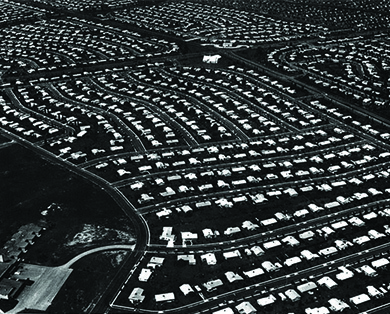| << Chapter < Page | Chapter >> Page > |
Several factors contributed to this development. During World War II, the United States had suffered from a housing shortage, especially in cities with shipyards or large defense plants. Now that the war was over, real estate developers and contractors rushed to alleviate the scarcity. Unused land on the fringes of American cities provided the perfect place for new housing, which attracted not only the middle class, which had long sought homes outside the crowded cities, but also blue-collar workers who took advantage of the low-interest mortgages offered by the GI Bill.
An additional factor was the use of prefabricated construction techniques pioneered during World War II, which allowed houses complete with plumbing, electrical wiring, and appliances to be built and painted in a day. Employing these methods, developers built acres of inexpensive tract housing throughout the country. One of the first developers to take advantage of this method was William Levitt, who purchased farmland in Nassau County, Long Island, in 1947 and built thousands of prefabricated houses. The new community was named Levittown .
Levitt’s houses cost only $8,000 and could be bought with little or no down payment. The first day they were offered for sale, more than one thousand were purchased. Levitt went on to build similar developments, also called Levittown, in New Jersey and Pennsylvania ( [link] ). As developers around the country rushed to emulate him, the name Levittown became synonymous with suburban tract housing, in which entire neighborhoods were built to either a single plan or a mere handful of designs. The houses were so similar that workers told of coming home late at night and walking into the wrong one. Levittown homes were similar in other ways as well; most were owned by white families. Levitt used restrictive language in his agreements with potential homeowners to ensure that only whites would live in his communities.

In the decade between 1950 and 1960, the suburbs grew by 46 percent. The transition from urban to suburban life exerted profound effects on both the economy and society. For example, fifteen of the largest U.S. cities saw their tax bases shrink significantly in the postwar period, and the apportionment of seats in the House of Representatives shifted to the suburbs and away from urban areas.
The development of the suburbs also increased reliance on the automobile for transportation. Suburban men drove to work in nearby cities or, when possible, were driven to commuter rail stations by their wives. In the early years of suburban development, before schools, parks, and supermarkets were built, access to an automobile was crucial, and the pressure on families to purchase a second one was strong. As families rushed to purchase them, the annual production of passenger cars leaped from 2.2 million to 8 million between 1946 and 1955, and by 1960, about 20 percent of suburban families owned two cars. The growing number of cars on the road changed consumption patterns, and drive-in and drive-through convenience stores, restaurants, and movie theaters began to dot the landscape. The first McDonalds opened in San Bernardino, California, in 1954 to cater to drivers in a hurry.

Notification Switch
Would you like to follow the 'U.s. history' conversation and receive update notifications?